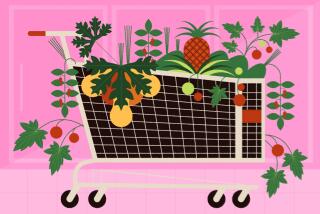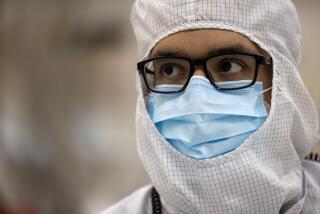Experiments May Help Space Garden Bud : Science: Researchers are working on chambers that can grow food without soil or sunlight. Recycling of nutrients is a key factor.
KENNEDY SPACE CENTER, Fla. — Deep inside a laboratory stripped of soil and shielded from the sun, NASA is growing potatoes to see if they might thrive in a faraway, topsy-turvy garden--one in outer space.
It is the field of the future, this sealed, two-story plant chamber that uses liquid nutrients in lieu of dirt, transforms condensation into water and recycles water, oxygen and, ultimately, even inedible plant parts.
“For any kind of extensive manned exploration or habitation in space, you’re going to have to be able to make certain you have enough oxygen, water, food, as well as all the technological niceties that have been so elaborately described in all the sci-fi books and movies,” said Paul Buchanan, head of biomedical operations and research at Kennedy Space Center.
“To do that, you’re going to have to recycle.”
Economy is vital in space travel, both in size and cost.
“The farther you get away, say if you’re on a moon colony or a Mars colony, it becomes that much more expensive to continually supply,” said NASA plant physiologist Ray Wheeler.
“If you didn’t have any regenerative capabilities, you’d need a lot of extra storage,” Wheeler said. “So if one supply ship didn’t make it, you’d have enough to get you through until the next one.”
A trip to Mars, for example, is expected to take about a year--add another year on the planet and another year back.
The plant chamber, part of NASA’s Controlled Ecological Life Support Systems program, would reduce, if not eliminate, the need for grocery deliveries to outer space. Scientists believe a greenhouse also would be therapeutic, especially for astronauts who enjoy gardening.
It is nothing like back-yard gardening.
There is no need for shovels or watering cans or sacks of fertilizer, no battle with weeds or bugs. Computers control light, heat, water, mineral replenishment, atmospheric gases, everything. Plants are displayed on television monitors in the adjacent control room.
Green thumbs are nice but unnecessary.
“You don’t have to go in every day and fluff the plants,” Buchanan said. “But you will have to monitor how they grow.”
Gardening was never so easy, so remote, yet so complex. Here’s how Buchanan envisions plant chamber chores:
“You will do some chemical analysis of the nutrients. You will make absolutely certain that the nutrient revitalization system is working as it should. You will monitor the air inflow and outflow. You will monitor the character of the condensate.”
NASA’s high-tech hothouse is in a hangar-turned-laboratory at Cape Canaveral Air Force Station. True to form, the white, cylindrical container is made of recycled material--the chamber originally was used to test Mercury space capsules.
Plants rise from four tiers of trays that ring the inner walls, providing 65 square feet of growing area. White roots, covered by plastic sheets, dangle in a quarter-inch-deep solution of water and nutrients that constantly circulates. Cooling coils collect moisture and convert it into water. Nearly 40,000 watts’ worth of light shine from banks of lamps.
Basic hydroponic, or soil-less, approaches have been followed since the first chamber seeds were sown in late 1988. The chamber has held only one kind of plant at a time. Scientists will try mixing crops next year.
So far, the chamber has produced dwarf wheat, soybeans, lettuce and now, for the first time, white potatoes. Tiny potato seedlings with stubby roots were planted early in June. By July, they bore marble-sized potatoes.
Chamber plants require less growing time and produce higher yields than those cultivated outside due to careful regulation of temperature and light, extra nutrients and close planting. The amount of inedible plant parts is about the same.
Researchers use bacteria and fungi to break down cellulose from plant waste--roots, stems and leaves--into simple sugars that could be added to astronauts’ food or fed to fish. Tilapia, an African fish raised in laboratory aquariums, feast daily on the degraded material.
The goal is to also recycle human waste for plant nutrients. Work in this area is expected to begin next year.
Similar recycling is planned for Biosphere II, an enclosed ecosystem in Oracle, Ariz., that will be home to four men and four women for two years. They hope to move into the domed structure this fall.
NASA scientists have visited the site and talked to the “biospherians” but expect the project to have little application to their space gardening efforts. Biosphere II, for instance, will rely on sunlight for plant growth and is a sort of mini-Earth complete with ocean, marsh, savannah and desert.
The missing ingredient for NASA’s plant chamber, and any other Earth-based research, is weightlessness. No one really knows how plants might fare after months and years in space. It is believed that roots and shoots would point every which way because of the lack of gravity.
NASA has more seeds to sow, and harvest, before testing the plant chamber in space.
William Knott, the scientist in charge of the chamber, plans to grow about a dozen crops, including sweet potatoes, string beans, radishes, carrots, peanuts, tomatoes and possibly rice. The crops are being tested in small-scale chambers at universities around the country.
Tomatoes were added at the recommendation of nutritionists and dietitians who spent months debating what astronauts would need--and want--to eat on long voyages.
“They said: ‘We believe we can probably give you a good set of menus that will last you about three years except for one thing. You need one key element to make all of this work,’ ” Buchanan said. “We said: ‘What is that?’ Tomatoes.
“If you add tomatoes, you begin thinking in terms of Italian recipes and a few other things, and you can make all of it pull together. You’re not eating like a rabbit or a grazing quadruped of some sort. You’re actually eating prepared, presented food.”
In space, astronauts dine primarily on preserved and freeze-dried food that can be warmed in a convection oven. Reviews are mixed.
Astronaut G. David Low rates space shuttle meals as “great,” even after 1 1/2 weeks in space. But as for his judgment, he notes: “Growing up, I always loved cafeteria food.”
The astronauts on space shuttle Columbia’s medical research mission in June found themselves adding more and more taco sauce to food. M. Rhea Seddon, a physician, said the meals were bland and monotonous.
“We were all really looking forward to fresh fruit and vegetables when we got back,” Seddon said.
Astronauts often report a loss of taste in space. Cosmonauts aboard Mir, the Soviet space station, grow onions to spice up their diets during their half-year stints. Details of Soviet gardening efforts are sketchy; pictures of Mir’s hydroponic plant chamber show it to be about the size of a suitcase.
“It’s better than anything we have because it’s up there in space,” said biologist Robert Mac Elroy, who works on ecological life support systems at NASA’s Ames Research Center in Mountain View, Calif.
NASA scientists expect some version of the Kennedy Space Center plant chamber to be tested on the planned space station later this decade, but used primarily for interplanetary travel. A presidential panel earlier this summer submitted four proposals for sending Americans back to the moon in 12 to 14 years and to Mars between the years 2014 to 2016.
Because the orbiting space station would be in easy reach of supply ships, scientists figure a simpler alternative for that spacecraft might be the salad machine, a refrigerator-sized greenhouse, under development at Ames, designed to grow lettuce and other small vegetables in pull-out shelves. It also uses hydroponic methods.
At Johnson Space Center in Houston, the focus is on soil--the otherworldly kind. Agronomist Don Henninger uses Minnesota basalt and a specially prepared, crushed glass to simulate lunar soil. So far, wheat and lettuce have thrived in the black mixture.
There is no recipe, at least not yet, for Martian soil.
Henninger envisions moon and Mars colonists using both hydroponic and soil-based systems to grow food. Although hydroponic chambers like the one at Kennedy Space Center could produce more than soil, they would be more susceptible to equipment failure.
“It’s just like on Earth,” Henninger said. “Soil tends to be a much more forgiving way of doing business.”






